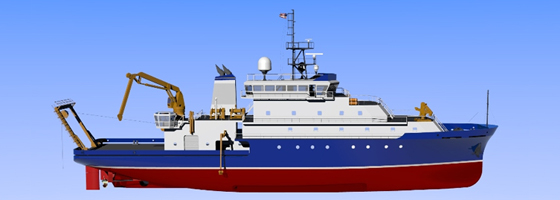Navy designs new research ship with oceanographers in mind

Last month shipbuilders laid the keels for two new state-of-the-art research ships funded by the U.S. Office of Naval Research. The goal is to facilitate research that will both benefit the Navy and U.S. citizens.
The Navy arranged a competitive proposal process to decide which organizations would be awarded use of the ships. Several oceanographic institutions and universities gave proposals at a pre-bid meeting. Institutions had to prove that they could afford to operate and maintain the ship. Their research also had to be relevant to Navy interests according to Oceanus Magazine.
Four bids were eventually submitted. A Navy committee then chose the Woods Hole Oceanographic Institution and Scripps Institution of Oceanography to charter the ships.
The ships are named AGOR 27 and AGOR 28. AGOR stands for Auxiliary General Purpose Oceanographic Research. That’s exactly what the ships will facilitate, according to Robert Munier, WHOI vice president for marine facilities and operations. He expects that the AGOR 27 will be used in any field of ocean study from oceanography to biology to geology.
The AGOR 27 is smaller than other vessels WHOI uses. It has less living space for scientists and smaller labs below deck. Munier says the size is mainly due to budget constraints, and he’s not complaining. “The objective of the small ship is to get the most bang for the buck,” Munier said.
Since the $88-million ship is on the Navy’s strained buck, WHOI certainly isn’t ready to bite the budget that feeds research. Besides, Munier said, new technology on the ship will still enable it to do most of what WHOI’s aging larger ships can do. That includes maintaining a speed of 12 knots and holding position through eight-foot swells in the open ocean.
The Navy designed the AGOR ships, but Munier said this is a ship built for scientists with the oversight of scientists. There won’t be any pesky 50 caliber turrets to slide by on the way to one of the two on-deck cranes.
The ship will have 20 beds for crew members and 24 beds for scientists.
The labs below deck will host four different sonar devices. Munier said one will profile long distance at lower resolution. One has less distance capability, but higher resolution. One will expressly measure depth, and one will monitor sediment at the ocean floor. The sonar devices are integrated into the ships’ hull design to minimize interference as it travels through the water.
A conductivity temperature depth sensing system onboard has its own hoisting mechanism able to pull the unit aboard even in rough seas.
The AGOR ships also have space to house specialty monitoring equipment for any scientific research. Munier said each expedition will likely require different equipment depending on the study.
Plans for the ships’ drive system include high-tech directional thrusters controlled by an advanced electronic system. It also will have a 5300-horsepower diesel-electric power system that should make the ship more efficient.
Dakota Creek Industries is currently building both ships at their Anacortes, Wash. shipyard.
Munier said WHOI has a representative at the ship yard to aid in decision making as the ship is built. He said no large changes will be made, but planning cannot account for construction issues or unforeseen assembly problems.
Expected delivery of the finished products is late 2014. Both AGOR 27 and AGOR 28 should be ready for missions in early 2015 after a trial period.




0 comments